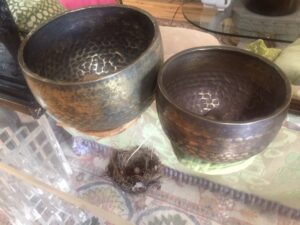 After eighteen months we need deep relaxation, muscle regeneration, and better concentration. HOW TIMELY that JF sent me two “singing” bowls from his home altar. His collection of Japanese standing bowls includes one quite large at twelve inches, and one at nine and a half inches. Japanese standing bowls hold the distinction of hand hammered (repousse) patterns of circles and a blessing in characters around the rim. JF passes his altar and periodically rings the bowls, and feels all the “improvements” for a REASON. Let’s look at why, and what they’re worth.
After eighteen months we need deep relaxation, muscle regeneration, and better concentration. HOW TIMELY that JF sent me two “singing” bowls from his home altar. His collection of Japanese standing bowls includes one quite large at twelve inches, and one at nine and a half inches. Japanese standing bowls hold the distinction of hand hammered (repousse) patterns of circles and a blessing in characters around the rim. JF passes his altar and periodically rings the bowls, and feels all the “improvements” for a REASON. Let’s look at why, and what they’re worth.
First discovered healing properties of Singing Bowls
Why have they been struck for thousands of years for both spiritual and therapeutic healing? I bet JF “banged the gong” often these past eighteen months of forced work from home.
Ancient people became aware of the healing properties of sound produced by bells 12,000 years ago, if the archaeological finds prove correct. The modern theory says sound balances both sides of the brain via vibrations of a certain frequency. Since we “discovered” DNA, proponents of “the sound bath” say the “ommmmmm” of the bowl/bell “awakens” DNA. Some say the right sound “awakens” the adrenal gland. We didn’t know terms like “DNA” back in the day. The old way of thinking said sound balanced the astral channels (chakras). Certain musicologists measured the frequencies of such perfectly crafted bowls that produce frequencies about 4-6 kHz. Only those physicists among us will understand. Perhaps ancient metal workers worked from the ‘effects’ backwards, and not the science forward…
Riding a Wave
Today we know our brains produce electromagnetic waves. In the brain’s normal conscious state called ‘beta,’ in deep sleep, “delta,” yet in mediation, brains produce beneficial “alpha” waves. When such bowls are “tuned” right, and used correctly by the right brain in the right person, THEY help produce Alpha waves. Physician Hans Jenny (d 1972), who pioneered sound therapy or modal vibration studies, discovered when the brain hears certain types of sound diligent scientists see Alpha waves.
Singing and striking bowls actually sing because the sound lasts longer than the strike or rub to the bowl’s rim. The classic definition of a singing bowl describes a bowl where you rotate a mallet around the rim. The striking bowl is struck. Aside from the difference in nomenclature, both vibrate, as JF’s dog will tell us as he cocks his head to the sound.
Among other spiritual practices, such bowls are used in Buddhist chants and meditations. Historically sound comes from struck bells, called standing or resting bells, bowl-shaped invented bells. Originating in China some of the oldest bronze objects are goblet shaped iron bells, found in groups of sizes (16th -11 century BCE). These bells represent advanced technological skill in acoustics, metallurgy, etc.). The spread of Buddhism in 2-7 CE called for larger ritual bells, similar to JF’s.
Good Vibrations
A struck or singing bowl is a musical instrument classified as an struck idiophone. This means the whole of the object, without any other element, is the whole instrument, as the whole of the bell vibrates. People who play the spoons also play struck idiophones.
Maximum vibration happens around the rim of the bowl which echoes around the whole of the open bowl. The engineering marvel happens when a bowl is crafted just right. I don’t understand but your engineers probably do.
“Tibetan Singing Bowl” bought online today don’t show any historical precedent in Tibet, as opposed to the struck bell in China and Japan. A pair of folk musicians introduced the West to the “Tibetan” singing bowl in 1972.
DF’s bells are made of “bell metal,” a classic alloy of copper and tin, cast as molten metal, and then hand hammered into shape. The Japanese name for his bowls are namarin. We call larger temple bells, up to three feet, daikin. Both appear late 19th early 20th century and not ordered online as modern versions. I believe the value of the pair significant- $2,800.
Pingback: Rejuvenate with Japanese Singing Bowls - Elizabeth Appraisals